Art Forms
Pulluvapaattu
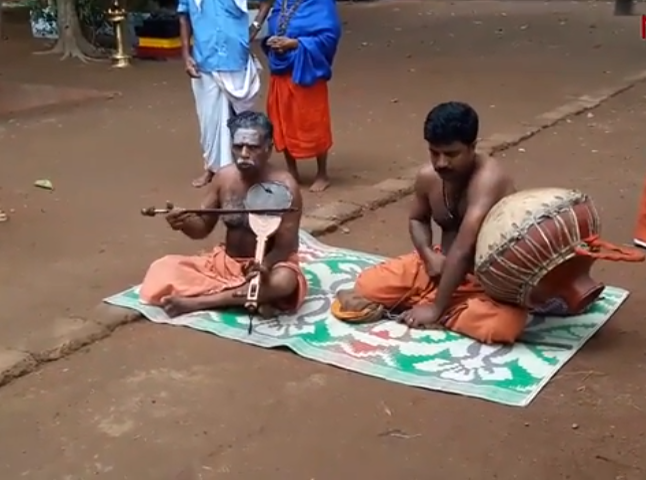
The belief is that this Art form was formulated soon after the restoration of the land of Kerala from the Arabian Sea by Lord Parasurama. The newly acquired land was donated by Parasurama to the Brahmins who were brought down from North India. Finding that the soil contained much salt which prevented them from growing crops and vegetables besides non availability of pure drinking water, they expressed their inability to continue there and requested Lord Parasurama to rescue them from this situation. The embarrassed Lord sought guidance from Lord Parameswara who in turn deputed His "Bhoothas" and "Serpents" to do the needful in the matter. Accordingly the Serpents reduced the salt contents of the soil to the permissible level resulting the vegetation in success. The rejoiced Parasurama instructed the Brahmins to set apart one fourth of the land holding in each family to be earmarked for the comfortable stay of the Serpents, which practice is almost still in vouge even though the extent of area is considerably reduced over a lapse of time.
The inhabitants neglected to observe the rituals to the serpents which resulted in contracting many ailments. The Bhramins pleaded for relief to Lord Parasurama who then prayed to Lord Parameswara for solace. The latter instructed to please the Serpents by performing certain rituals. A band of new sect who were later known as 'Pulluvas' were brought in to perform the rituals for propitiating the Serpents. The performance of these rituals later came to be known as Sarpamthullal, Kalamezhthu and Pulluvanpattu. It is astonishing to note that even though thousands of years have passed since then, the Pulluva Community members alone are the only authorised persons to perform these rituals.
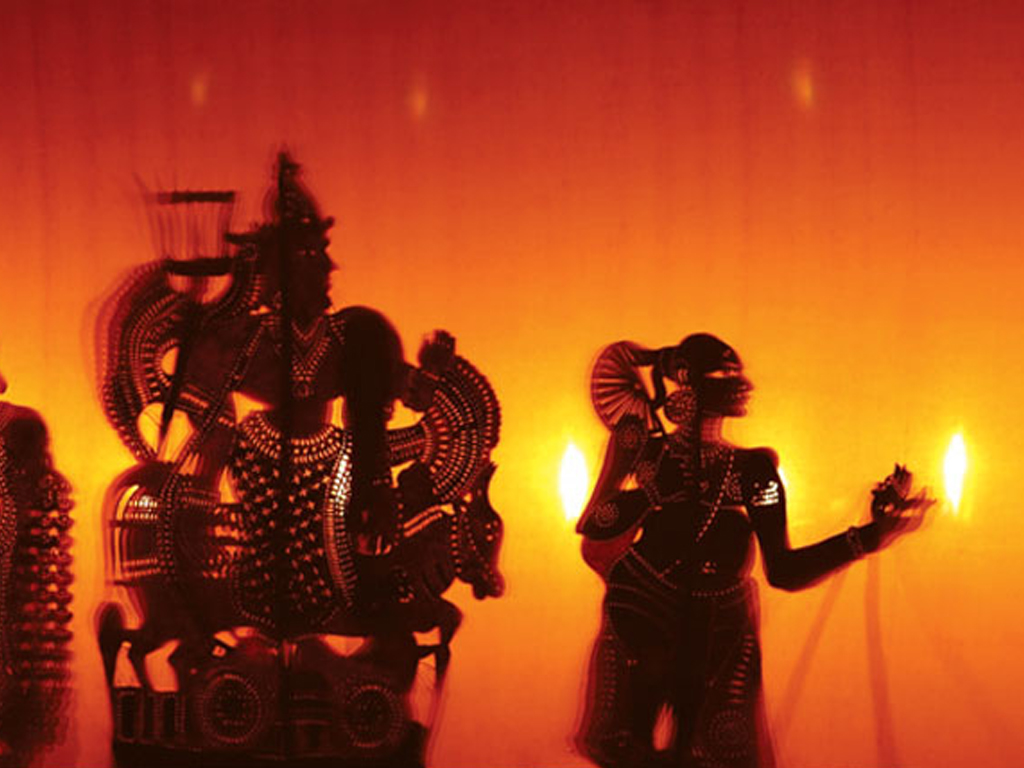
'Pava' means doll and 'koothu' means dance. It is a traditional glove puppetry show native to Kerala. This art form is performed mostly in the rural areas. This tradition can be traced back to almost 4 centuries (the 18th century) from Paruthippuly village of the Palakkad District. It is believed that goddess ‘Vishnumaya’ assumed the form of a beautiful puppet to fascinate the Asuras (demons). It is practiced in the interior villages of Palakkad district and its surrounding areas. For several generations a few families from the Paruthippully village of Palakkad, known as ‘Andi Pandarams’, have been practicing this form of puppetry.
TholPavaKoothu, the unique shadow puppet theatre form of Kerala, South India, is preserved as a family tradition by the Pulavars.
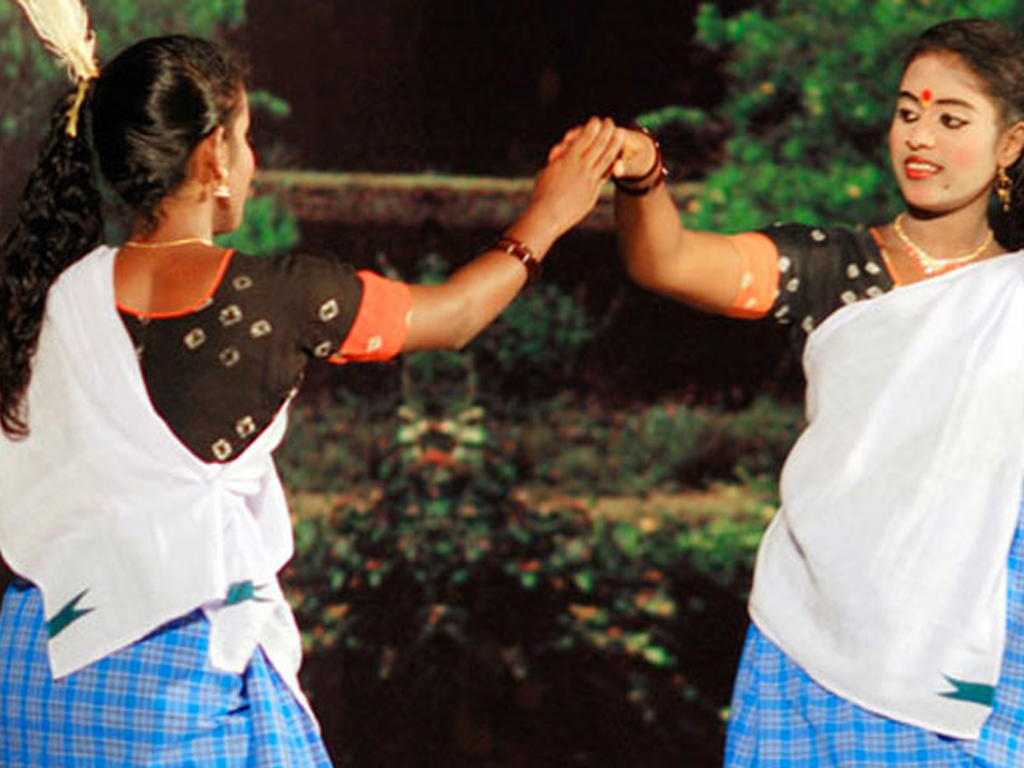
Kakkarissi natakom is a satirical dance-drama based on the puranic legends of Lord Siva and his consort Parvati when they assumed human forms as Kakkalan and Kakkathi - a nomadic tribe of fortune tellers. The legend only serves as a skeletal framework for the play, which often turns into a subtle critique of contemporary society. The language is a blend of Tamil and Malayalam. The chief characters are Kakkalan, Kakkathi, Vetan, Velichappadu, Thampuraan and the ubiquitous Jester. The Dholak, Ganchira,Chenda and the Harmoniumprovide the background score.
Kaakkaarissi Naatakam is a popular entertainment among the backward communities of Kerala. This art can still be seen in its original flavour and style in the village of Nedumangadu in Thiruvananthapuram district. In the south-central region of Kerala, it is found in Kurumpala, Karakkat, Karunagapally, Panthalam, Cheruvally, Ambalapuzha, Mankombu etc. Here it is presented by the Paanar and Kummaalar communities. In Kilimanoor and Nedumangadu it is presented by Kurava and Ezhavas.
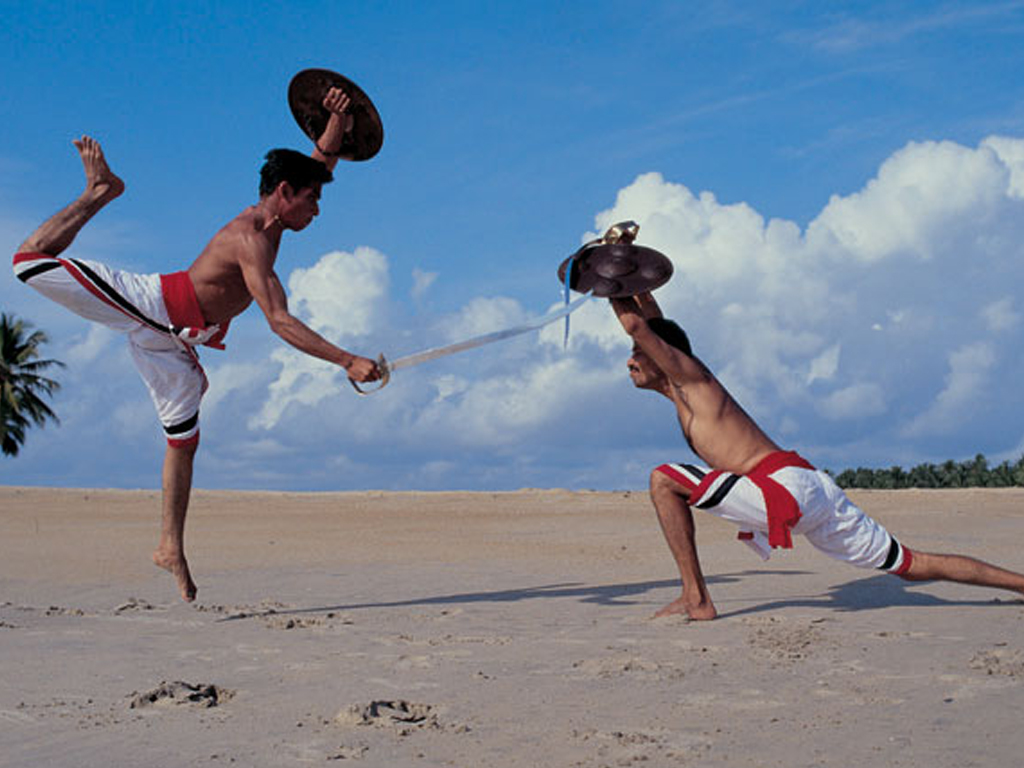
Kalarippayattu is the only form of the most ancient traditional systems of physical, culture, self-defence and martial techniques still in existence. It is believed to have had its origin in Kerala; the tiny state situated South West of India.
Apart from the physical abilities qualities like concentration, confidence, bravery and fearlessness are achieved by the rigorous training in Kalarippayattu. Boys and girls from the age of seven onwards were enrolled in the Kalari and underwent years of training and continued regular practice even after they were trained.
In short, Kalarippayattu is a unique and magnificent art of physical culture and self-defense.Methods of fighting with the weapons like Dhanus (bow and arrow), Sword, Spear, Churika (a different type of sword), Dagger, Urumi (a kind of flexible sword), Mace etc were practiced in the Kalaris.
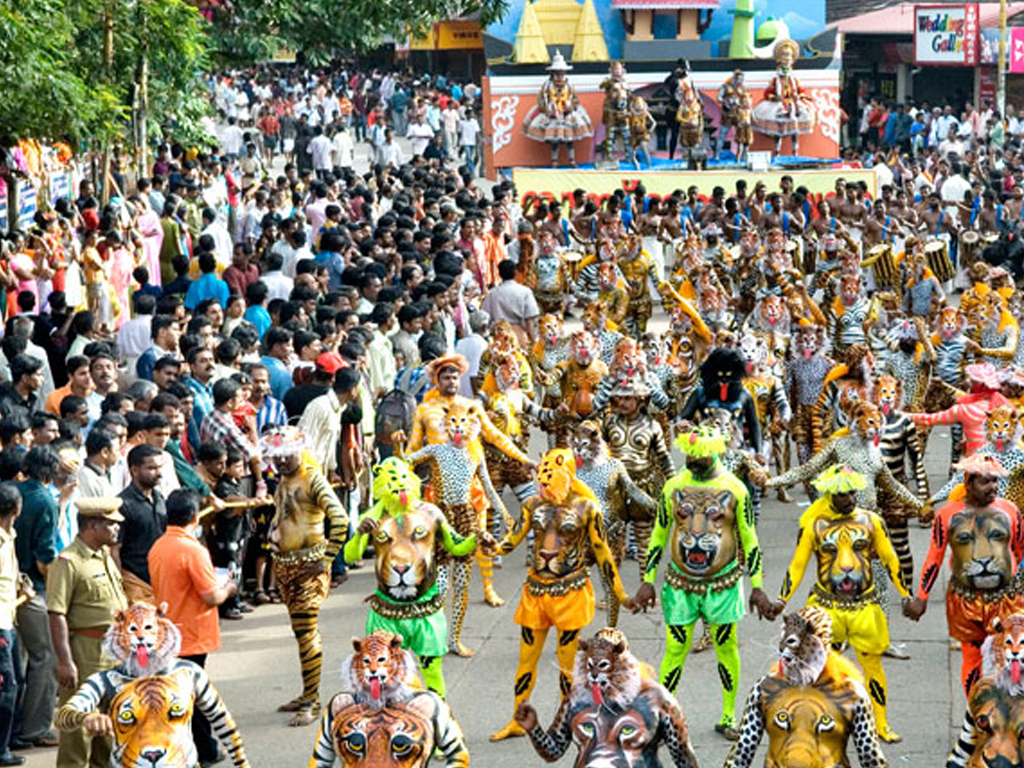
This art form is performed in Trichur and Palghat districts. It is also known as Kaduvaakali. Dancers numbering three or more dress themselves up like tigers, usually covered with yellow paint, with red and black designs on it.
There are enactments such as the tiger preying on a goat, and a tiger being hunted by a game-hunter. The made-up tigers present vigorous dancers to the loud beating of percussion instruments like udukku,thakil etc.
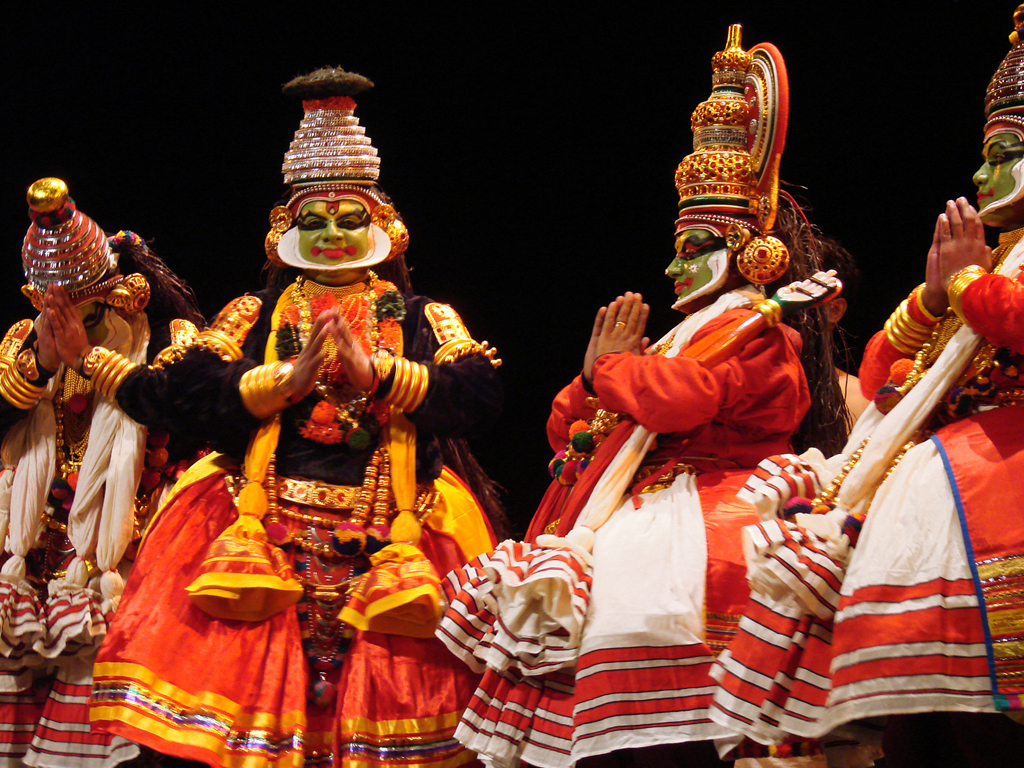
Krishnanaattam was the dance-drama created by the Zamorin of Calicut, which deals with the life and activities of Lord Krishna. Its technique had the foundation of the folk drama and its content had a religious inspiration. It is believed that the Zamorin had a vision of Lord Krishna who gave the chieftain a peacock feather, which became the living symbol of this dance drama. Krishnanaattam players wore a peacock feather and thus commemorated the vision of the chieftain. Krishnanaattam's pattern of art was based on the Geetha Govinda. Geetha Govinda describes the turmoil in the love life of Krishna and Radha through words spoken by Krishna, Radha and a sakhi, companion.

Thottam Pattu is a vocal ballad sung just before performing the Theyyam ritual. These are played in Theyyam temples before the commencement of Theyyam Art. Thottam Pattu is invocative. This is a mythological belief that by performing this ritual, the performer will be possessed by divine spirits. Thottam Pattu, the ritualistic songs which accompany the performance elaborate the legends related to the deities. Percussions such as Chenda and Thudi accompany the songs.
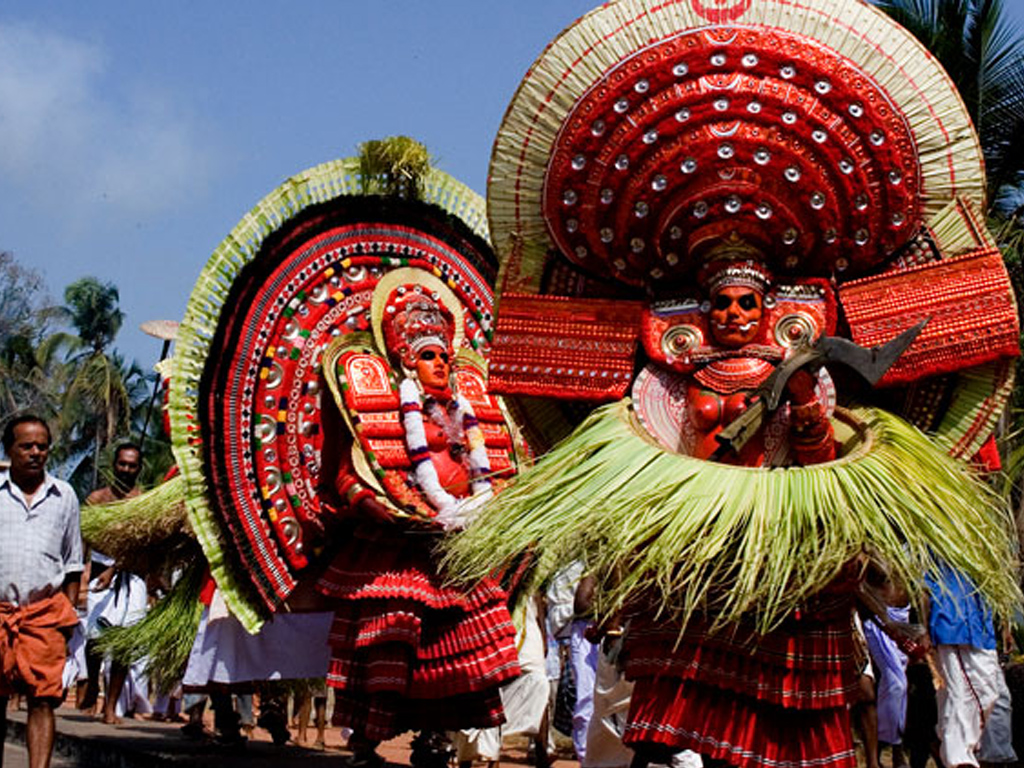
Theyyam or Theyyaattam is a pattern of hero worship performed in Kolathunaad, a territory comprising the present Cannanore District and Badagara Taluk of Kerala State. It is a ritual and a folk-dance form supported by a vast literature of folk songs. Theyyam is a corruption for Deyvam ‘God’. 'Aattam' means dance. Thus 'Theyyaattam' means the God’s Dance.
In Kolathunaad and other places (Southern portion of Kolathunaad), Theyyam is known as Thira or Thirayaattam. There, the performance is conducted on a masonry stage called Thara and the word Tharayaattam was probably changed into Thirayaattam in course of time. The term Thirayaattam itself may mean beautiful dance.
The person who plays and personifies the deity is generally called ‘Kolam’. The word Kolam means figure or shape or make-up in Tamil and Malayalam. In Tulunad, north of Kolathunaad, the custom of Kolam dance is widely prevalent as a form of worship of the Bhootas or spirits. There, the dance was conducted before the sthaanams, where the Bhoothas or the spirits used to reside.
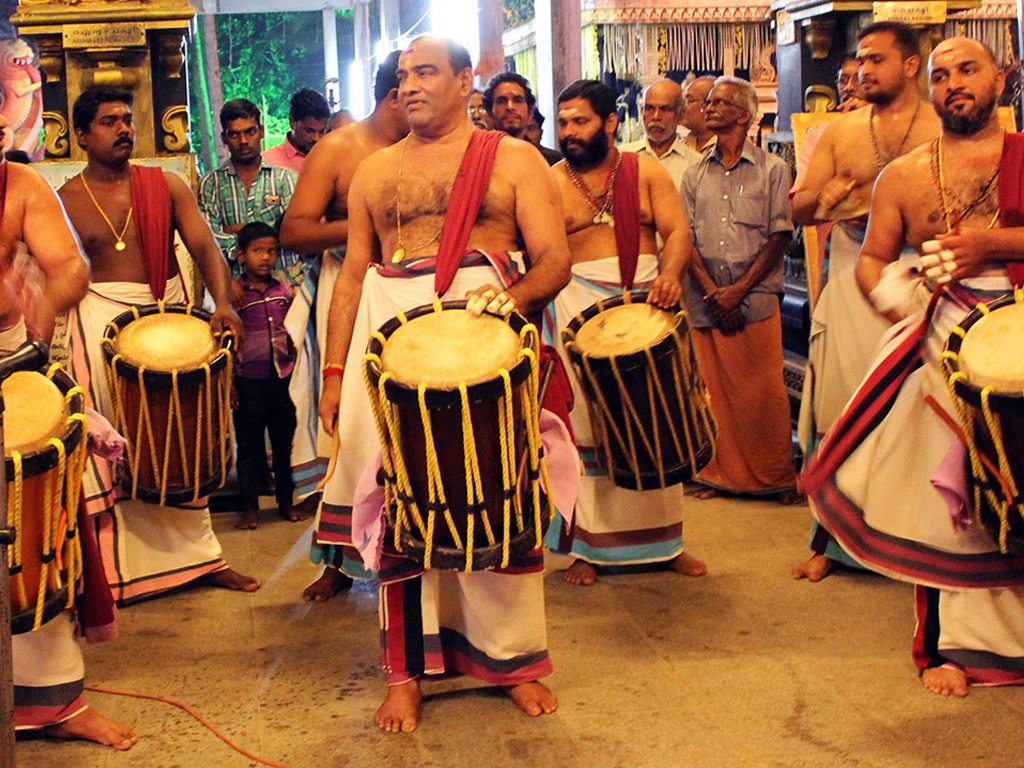
Thayambaka or tayambaka is a type of solo chenda performance that developed in the south Indian state of Kerala, in which the main player at the centre improvises rhythmically on the beats of half-a-dozen or a few more chenda and ilathalam players around.
In Kolathunaad and other places (Southern portion of Kolathunaad), Theyyam is known as Thira or Thirayaattam. There, the performance is conducted on a masonry stage called Thara and the word Tharayaattam was probably changed into Thirayaattam in course of time. The term Thirayaattam itself may mean beautiful dance.
A thayambaka performance on the chenda has thus its focus on the stick-and-palm rolls produced on the itantala (treble) of the chenda, while the rhythm is laid by his fellow instrumentalists on the valanthala (bass) chendas and ilatalam (cymbals).[1]. Thayambaka, believed to have flourished during the feudal era, spans an average of 90 minutes. It begins at a slow pace before scaling on to a medium tempo and eventually culminating in high, frenzied speed. It has a skeletal pattern on which the performance progresses, but the main performer has the liberty to improvise and innovate to showcase his grip of rhythm, finesse of techniques and cerebral brilliance. In fact, thayambaka is one chenda concert that allows maximum individual freedom to the main player.
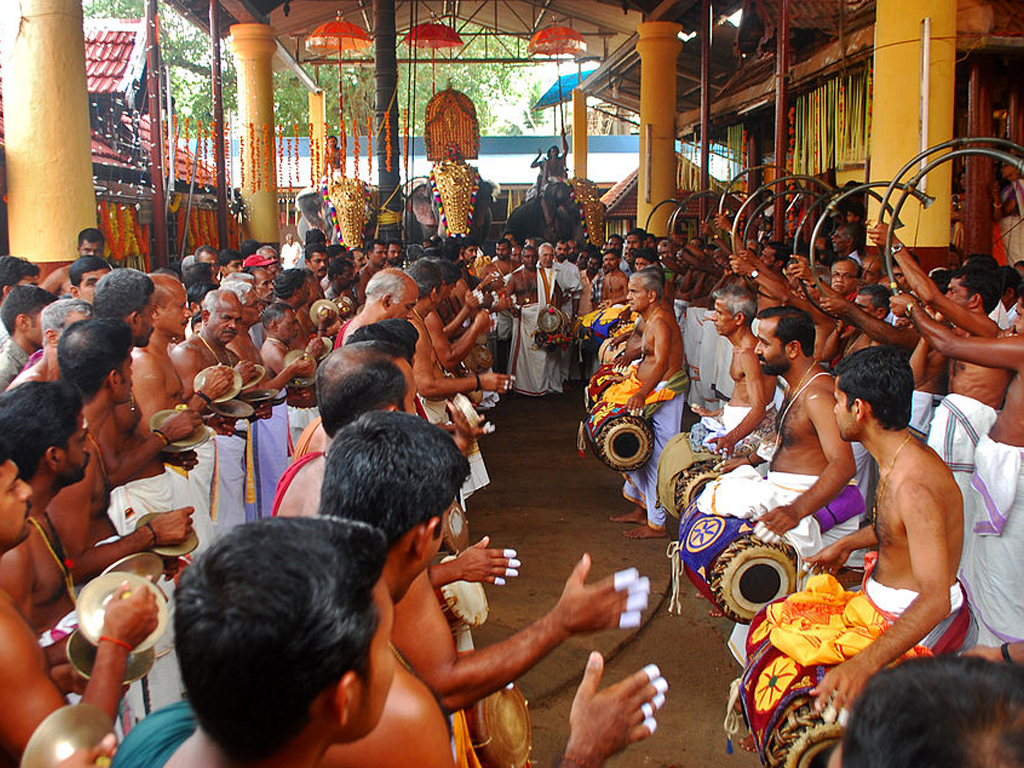
Panchavadyam is a classical performance of various musical instruments that are endemic Kerala. As the term “pancha” in Sanscrit means five, Panchavadyam consists of five percussion instruments- Edakka, Elathalam, Kombu, Shudha Madhalam or Maddalam and Timila. The sankh(conch) and Kuzhal are also used along with these five instruments.
The Maddalam, which is a kind of drum, is regarded as a divine percussion instrument (Deva Vadya) which was used as a musical accompaniment during the Tandava Nritya or the ‘Primeval Dance of Lord Siva,’ the Destroyer. Maddalam consists of two varieties- Sudha Maddalam, the one that is tied round the waist of the player with a cloth and the other is Toppi Maddalam which is much smaller and is hanged from the neck of the performer.
The Timila is made from polished Jack wood and is shaped like an hour-glass. The Edakka is made of wood and is a sensitive percussion instrument.
The Kombu made up of mostly copper or brass is a C-shaped wind instrument or trumpet which produces a high-pitched sound. The Elatalam is like an indigenous cymbal.
The performance of Panchavadyam is an integral part of the festivals of the Temples in Kerala, especially in Central Kerala and the music is considered divine. The most celebrated performance is put up at Thiruvambadi Temple during the Thrissur Pooram, and is known as the "Madathil Varavu" Panchavadyam. Panchavadyam provides ample opportunity for group as well as solo performance. In a Panchavadyam performance, the positioning of an artist is also of considerable importance. The musicians playing Timila and suddha-maddalam face each other while the Elathalam performer is positioned behind behind the timila artists and the komb musicians stand behind Suddha-Maddalam artists. Edakka drummers stand by facing each other and the sankh (conch) blower stands beside them
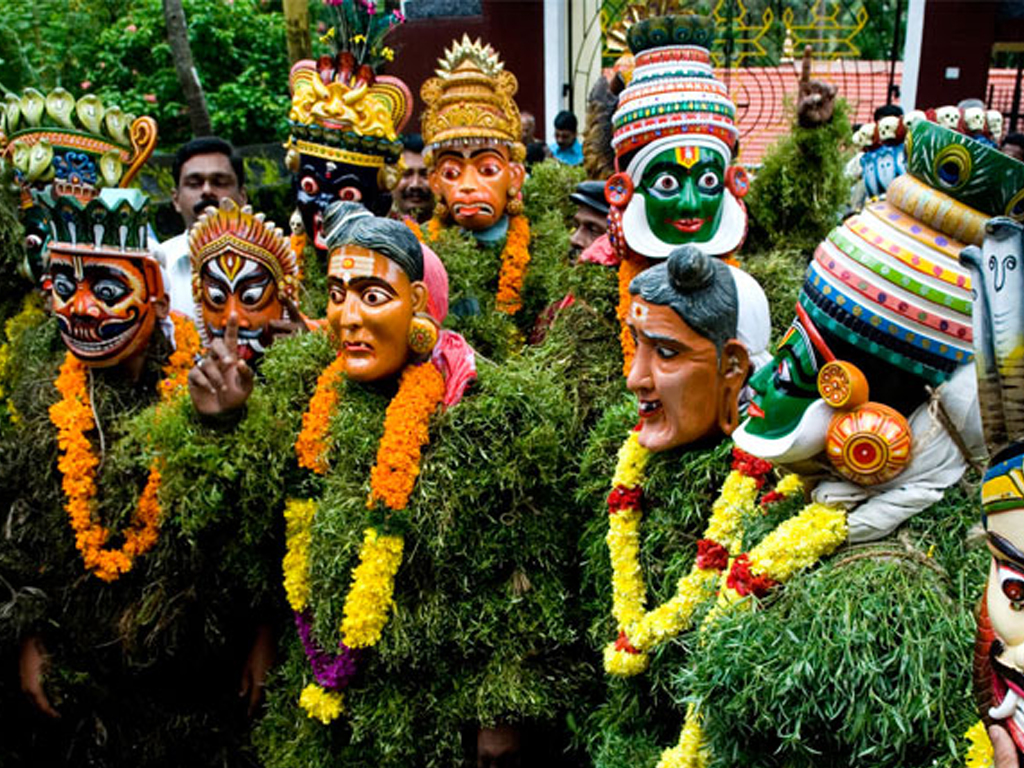
Kummaattikkali is the name given to a variety of mask dances popular in the Palakkad and Trissur Districts of Kerala. In Palakkad, they are associated with Devi Temples where they are performed as part of rituals, whereas in Trissur, the form is purely secular, used to entertain people during the Onam festival.
The costumes are a most interesting facet of Kummattikali. The dancers don a heavily painted colourful wooden mask depicting faces of Krishna, Narada, Kiratha, Darika, or hunters. These masks are usually made out of saprophyte, jack fruit tree, Alstonia scholaris, Hog Plum tree or the Coral tree.
The dancers wear skirts woven out of plaited grass. Some cover their whole body with bunches of grass for a more bushy appearance. The semblance is made more joyful with the 'talla' attached externally to the mask giving the appearance of a toothless open mouth. Dancers also hold and manipulate long sticks of residuary agricultural produce called 'Kummattikali': it is from this that the dance derives its name. Their dance is related to Shaiva myth. 'Thamma' (an old woman) walks in front with the help of a stick. Thamma is symbolic of mother of every being and everything.
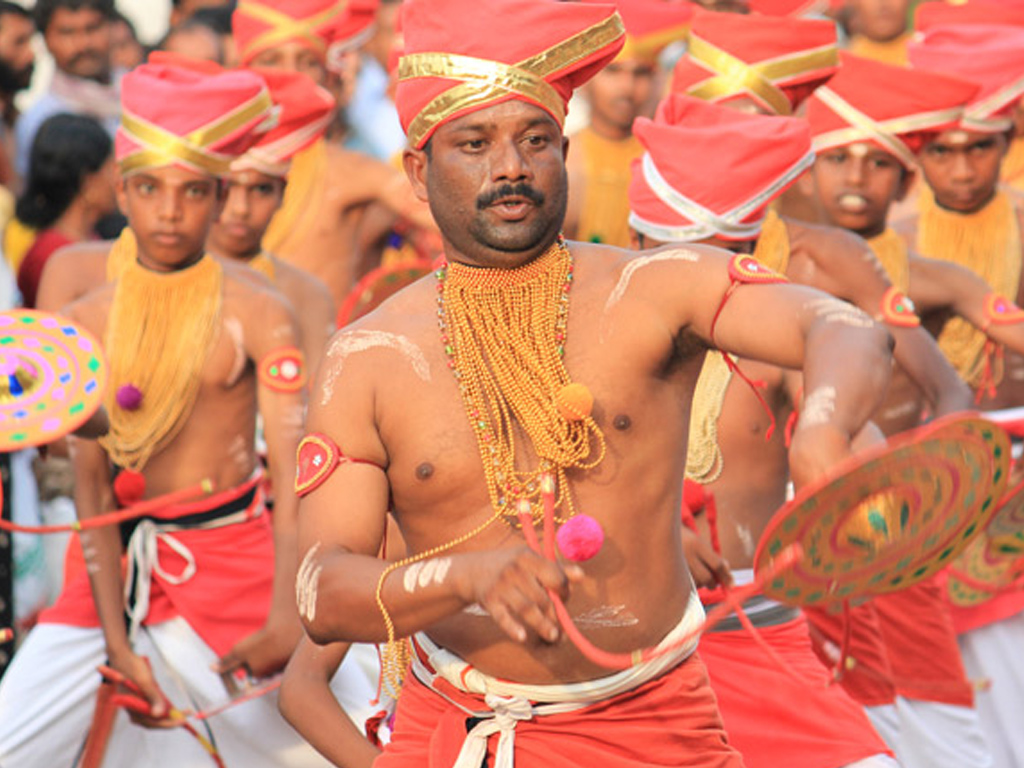
Velakali is a ritual art form presented in a temple courtyard or in the precincts of the temple tank. Among the martial folk arts, this is one of the most spectacular and extremely vigorous dances performed in Kerala. Originating among the Nairs, the traditional warriors of Kerala, this dance is now presented by other Hindu sects also.
The dancers numbering fifty or more are dressed up like traditional soldiers with colourful shields and shining swords. Sometimes the swords are replaced with long canes. They go through war like steps in a line to the accompaniment of martial music with vigour and force. They display fighting techniques by coming forward from the line. The musical instruments like Thavil, Suddha Maddalam, Elathaalam, Horns and Trumpets are used for this art. It is believed that this performance has reference to the war between the Kauravars and Pandavas or the war between Devas and Asuras from the Hindu epics.
This art form took shape at Ambalapuzha under the dispensation of the local Raja, Mathur Panicker family and they form a Velakali troupe.
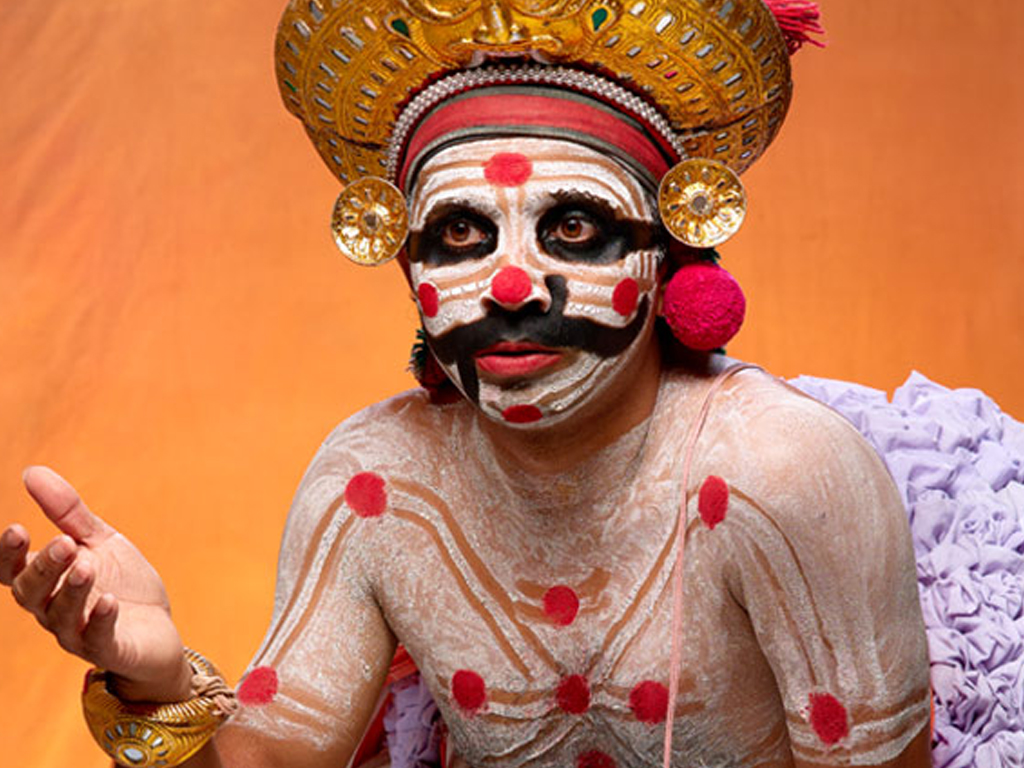
Chaakyaar koothu is one of the plays performed in temples. This is enacted in the special dance hall called Koothambalam, connected to the temples. It is performed by people belonging to the Chaakyaar community. The word koothu is derived from the Sanskrit term, Koordanam which means ‘dance’.
The Chaakyaar community is a group which earns its livelihood by performing Chaakyaar koothu and Koodiyaattam. There are many versions regarding the origin of the term Chaakyaar, The Chaakyaars are believed to be people who have been ostracized from the Namboodiri Brahmin Community.
The Chaakyaar koothu consists of two parts of which one is action and the other narration. In the earlier days, the action part of it was known as koothu. There are different types of koothu, known by different names like Mantraangam koothu, Anguliiyaangam koothu, Parakkum koothu, Matta Vilaasam koothu etc. When more than one actor performs on the stage, it is called Koodiyaattam. If the actors are not more than one, it is called Chaakyaar koothu. Chaakyaar koothu, is the narration of Puranic stories by the Chaakyaars who wear the attire of a joker and tell the story humourously.
Nobody knows how ancient this art form is. It is however clear from Chilappatikaaram that even during the reign of Chenkuttava Perumaal, Chaakyaar koothu was performed.
The Koothambalam constructed for the performance are edifices built according to Bharata Muni’s Natyasaastra. It mentions three types of theatres which are rectangular, quadrangular and triangular. The Koothambalam of Kerala has a green room inside at one end. Just in front of the green room is the stage. The remaining portion is left for the audience to sit.
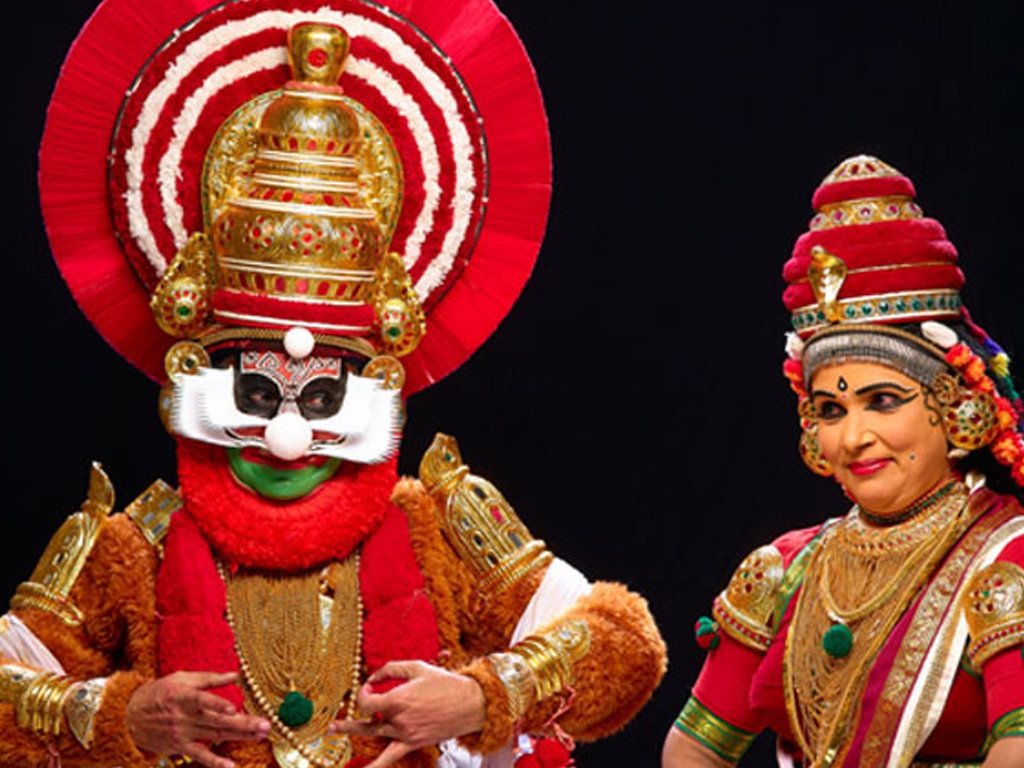
The art form Koodiyaattam is the forerunner of the dramatic arts of Kerala. The term Koodiyaattam signifies ‘Joint action’ by Chaakkyaars and Nangyaars propounding exclusively Sanskrit dramas. Literally, the name means ’composite dancing’. It is a composition of dramatics, abhinaya and dancing. It is perhaps the oldest dance-drama in existence in India.
Koodiyaattam is presented by members of the Chaakkyaar community. The word Chaakkyaar is formed from slaaghyavaakkukaar or slaaghayir giving stress to all the six qualities for good speech in them. The Chaakkyaar community preserved acting as their family duty and acquired for themselves an important position in the cultural history of Kerala. Tradition holds that there were 18 Chaakkyaar families of which 14 have been identified, among them only eight families existed now.
Pulluvapaattu

The belief is that this Art form was formulated soon after the restoration of the land of Kerala from the Arabian Sea by Lord Parasurama. The newly acquired land was donated by Parasurama to the Brahmins who were brought down from North India. Finding that the soil contained much salt which prevented them from growing crops and vegetables besides non availability of pure drinking water, they expressed their inability to continue there and requested Lord Parasurama to rescue them from this situation. The embarrassed Lord sought guidance from Lord Parameswara who in turn deputed His "Bhoothas" and "Serpents" to do the needful in the matter. Accordingly the Serpents reduced the salt contents of the soil to the permissible level resulting the vegetation in success. The rejoiced Parasurama instructed the Brahmins to set apart one fourth of the land holding in each family to be earmarked for the comfortable stay of the Serpents, which practice is almost still in vouge even though the extent of area is considerably reduced over a lapse of time.
The inhabitants neglected to observe the rituals to the serpents which resulted in contracting many ailments. The Bhramins pleaded for relief to Lord Parasurama who then prayed to Lord Parameswara for solace. The latter instructed to please the Serpents by performing certain rituals. A band of new sect who were later known as 'Pulluvas' were brought in to perform the rituals for propitiating the Serpents. The performance of these rituals later came to be known as Sarpamthullal, Kalamezhthu and Pulluvanpattu. It is astonishing to note that even though thousands of years have passed since then, the Pulluva Community members alone are the only authorised persons to perform these rituals.
PavaKoothu

'Pava' means doll and 'koothu' means dance. It is a traditional glove puppetry show native to Kerala. This art form is performed mostly in the rural areas. This tradition can be traced back to almost 4 centuries (the 18th century) from Paruthippuly village of the Palakkad District. It is believed that goddess ‘Vishnumaya’ assumed the form of a beautiful puppet to fascinate the Asuras (demons). It is practiced in the interior villages of Palakkad district and its surrounding areas. For several generations a few families from the Paruthippully village of Palakkad, known as ‘Andi Pandarams’, have been practicing this form of puppetry.
TholPavaKoothu, the unique shadow puppet theatre form of Kerala, South India, is preserved as a family tradition by the Pulavars.
Kakkarissi Natakom

Kakkarissi natakom is a satirical dance-drama based on the puranic legends of Lord Siva and his consort Parvati when they assumed human forms as Kakkalan and Kakkathi - a nomadic tribe of fortune tellers. The legend only serves as a skeletal framework for the play, which often turns into a subtle critique of contemporary society. The language is a blend of Tamil and Malayalam. The chief characters are Kakkalan, Kakkathi, Vetan, Velichappadu, Thampuraan and the ubiquitous Jester. The Dholak, Ganchira,Chenda and the Harmoniumprovide the background score.
Kaakkaarissi Naatakam is a popular entertainment among the backward communities of Kerala. This art can still be seen in its original flavour and style in the village of Nedumangadu in Thiruvananthapuram district. In the south-central region of Kerala, it is found in Kurumpala, Karakkat, Karunagapally, Panthalam, Cheruvally, Ambalapuzha, Mankombu etc. Here it is presented by the Paanar and Kummaalar communities. In Kilimanoor and Nedumangadu it is presented by Kurava and Ezhavas.
Kalarippayattu

Kalarippayattu is the only form of the most ancient traditional systems of physical, culture, self-defence and martial techniques still in existence. It is believed to have had its origin in Kerala; the tiny state situated South West of India.
Apart from the physical abilities qualities like concentration, confidence, bravery and fearlessness are achieved by the rigorous training in Kalarippayattu. Boys and girls from the age of seven onwards were enrolled in the Kalari and underwent years of training and continued regular practice even after they were trained.
In short, Kalarippayattu is a unique and magnificent art of physical culture and self-defense.Methods of fighting with the weapons like Dhanus (bow and arrow), Sword, Spear, Churika (a different type of sword), Dagger, Urumi (a kind of flexible sword), Mace etc were practiced in the Kalaris.
Pulikali

This art form is performed in Trichur and Palghat districts. It is also known as Kaduvaakali. Dancers numbering three or more dress themselves up like tigers, usually covered with yellow paint, with red and black designs on it.
There are enactments such as the tiger preying on a goat, and a tiger being hunted by a game-hunter. The made-up tigers present vigorous dancers to the loud beating of percussion instruments like udukku,thakil etc.
krishnanaattam

Krishnanaattam was the dance-drama created by the Zamorin of Calicut, which deals with the life and activities of Lord Krishna. Its technique had the foundation of the folk drama and its content had a religious inspiration. It is believed that the Zamorin had a vision of Lord Krishna who gave the chieftain a peacock feather, which became the living symbol of this dance drama. Krishnanaattam players wore a peacock feather and thus commemorated the vision of the chieftain. Krishnanaattam's pattern of art was based on the Geetha Govinda. Geetha Govinda describes the turmoil in the love life of Krishna and Radha through words spoken by Krishna, Radha and a sakhi, companion.
Thottam Pattu

Thottam Pattu is a vocal ballad sung just before performing the Theyyam ritual. These are played in Theyyam temples before the commencement of Theyyam Art. Thottam Pattu is invocative. This is a mythological belief that by performing this ritual, the performer will be possessed by divine spirits. Thottam Pattu, the ritualistic songs which accompany the performance elaborate the legends related to the deities. Percussions such as Chenda and Thudi accompany the songs.
Theyyam

Theyyam or Theyyaattam is a pattern of hero worship performed in Kolathunaad, a territory comprising the present Cannanore District and Badagara Taluk of Kerala State. It is a ritual and a folk-dance form supported by a vast literature of folk songs. Theyyam is a corruption for Deyvam ‘God’. 'Aattam' means dance. Thus 'Theyyaattam' means the God’s Dance.
In Kolathunaad and other places (Southern portion of Kolathunaad), Theyyam is known as Thira or Thirayaattam. There, the performance is conducted on a masonry stage called Thara and the word Tharayaattam was probably changed into Thirayaattam in course of time. The term Thirayaattam itself may mean beautiful dance.
The person who plays and personifies the deity is generally called ‘Kolam’. The word Kolam means figure or shape or make-up in Tamil and Malayalam. In Tulunad, north of Kolathunaad, the custom of Kolam dance is widely prevalent as a form of worship of the Bhootas or spirits. There, the dance was conducted before the sthaanams, where the Bhoothas or the spirits used to reside.
Thayambaka

Thayambaka or tayambaka is a type of solo chenda performance that developed in the south Indian state of Kerala, in which the main player at the centre improvises rhythmically on the beats of half-a-dozen or a few more chenda and ilathalam players around.
In Kolathunaad and other places (Southern portion of Kolathunaad), Theyyam is known as Thira or Thirayaattam. There, the performance is conducted on a masonry stage called Thara and the word Tharayaattam was probably changed into Thirayaattam in course of time. The term Thirayaattam itself may mean beautiful dance.
A thayambaka performance on the chenda has thus its focus on the stick-and-palm rolls produced on the itantala (treble) of the chenda, while the rhythm is laid by his fellow instrumentalists on the valanthala (bass) chendas and ilatalam (cymbals).[1]. Thayambaka, believed to have flourished during the feudal era, spans an average of 90 minutes. It begins at a slow pace before scaling on to a medium tempo and eventually culminating in high, frenzied speed. It has a skeletal pattern on which the performance progresses, but the main performer has the liberty to improvise and innovate to showcase his grip of rhythm, finesse of techniques and cerebral brilliance. In fact, thayambaka is one chenda concert that allows maximum individual freedom to the main player.
Panchavadyam

Panchavadyam is a classical performance of various musical instruments that are endemic Kerala. As the term “pancha” in Sanscrit means five, Panchavadyam consists of five percussion instruments- Edakka, Elathalam, Kombu, Shudha Madhalam or Maddalam and Timila. The sankh(conch) and Kuzhal are also used along with these five instruments.
The Maddalam, which is a kind of drum, is regarded as a divine percussion instrument (Deva Vadya) which was used as a musical accompaniment during the Tandava Nritya or the ‘Primeval Dance of Lord Siva,’ the Destroyer. Maddalam consists of two varieties- Sudha Maddalam, the one that is tied round the waist of the player with a cloth and the other is Toppi Maddalam which is much smaller and is hanged from the neck of the performer.
The Timila is made from polished Jack wood and is shaped like an hour-glass. The Edakka is made of wood and is a sensitive percussion instrument.
The Kombu made up of mostly copper or brass is a C-shaped wind instrument or trumpet which produces a high-pitched sound. The Elatalam is like an indigenous cymbal.
The performance of Panchavadyam is an integral part of the festivals of the Temples in Kerala, especially in Central Kerala and the music is considered divine. The most celebrated performance is put up at Thiruvambadi Temple during the Thrissur Pooram, and is known as the "Madathil Varavu" Panchavadyam. Panchavadyam provides ample opportunity for group as well as solo performance. In a Panchavadyam performance, the positioning of an artist is also of considerable importance. The musicians playing Timila and suddha-maddalam face each other while the Elathalam performer is positioned behind behind the timila artists and the komb musicians stand behind Suddha-Maddalam artists. Edakka drummers stand by facing each other and the sankh (conch) blower stands beside them
Kummaattikkali

Kummaattikkali is the name given to a variety of mask dances popular in the Palakkad and Trissur Districts of Kerala. In Palakkad, they are associated with Devi Temples where they are performed as part of rituals, whereas in Trissur, the form is purely secular, used to entertain people during the Onam festival.
The costumes are a most interesting facet of Kummattikali. The dancers don a heavily painted colourful wooden mask depicting faces of Krishna, Narada, Kiratha, Darika, or hunters. These masks are usually made out of saprophyte, jack fruit tree, Alstonia scholaris, Hog Plum tree or the Coral tree.
The dancers wear skirts woven out of plaited grass. Some cover their whole body with bunches of grass for a more bushy appearance. The semblance is made more joyful with the 'talla' attached externally to the mask giving the appearance of a toothless open mouth. Dancers also hold and manipulate long sticks of residuary agricultural produce called 'Kummattikali': it is from this that the dance derives its name. Their dance is related to Shaiva myth. 'Thamma' (an old woman) walks in front with the help of a stick. Thamma is symbolic of mother of every being and everything.
Velakali

Velakali is a ritual art form presented in a temple courtyard or in the precincts of the temple tank. Among the martial folk arts, this is one of the most spectacular and extremely vigorous dances performed in Kerala. Originating among the Nairs, the traditional warriors of Kerala, this dance is now presented by other Hindu sects also.
The dancers numbering fifty or more are dressed up like traditional soldiers with colourful shields and shining swords. Sometimes the swords are replaced with long canes. They go through war like steps in a line to the accompaniment of martial music with vigour and force. They display fighting techniques by coming forward from the line. The musical instruments like Thavil, Suddha Maddalam, Elathaalam, Horns and Trumpets are used for this art. It is believed that this performance has reference to the war between the Kauravars and Pandavas or the war between Devas and Asuras from the Hindu epics.
This art form took shape at Ambalapuzha under the dispensation of the local Raja, Mathur Panicker family and they form a Velakali troupe.
Chaakyaar koothu

Chaakyaar koothu is one of the plays performed in temples. This is enacted in the special dance hall called Koothambalam, connected to the temples. It is performed by people belonging to the Chaakyaar community. The word koothu is derived from the Sanskrit term, Koordanam which means ‘dance’.
The Chaakyaar community is a group which earns its livelihood by performing Chaakyaar koothu and Koodiyaattam. There are many versions regarding the origin of the term Chaakyaar, The Chaakyaars are believed to be people who have been ostracized from the Namboodiri Brahmin Community.
The Chaakyaar koothu consists of two parts of which one is action and the other narration. In the earlier days, the action part of it was known as koothu. There are different types of koothu, known by different names like Mantraangam koothu, Anguliiyaangam koothu, Parakkum koothu, Matta Vilaasam koothu etc. When more than one actor performs on the stage, it is called Koodiyaattam. If the actors are not more than one, it is called Chaakyaar koothu. Chaakyaar koothu, is the narration of Puranic stories by the Chaakyaars who wear the attire of a joker and tell the story humourously.
Nobody knows how ancient this art form is. It is however clear from Chilappatikaaram that even during the reign of Chenkuttava Perumaal, Chaakyaar koothu was performed.
The Koothambalam constructed for the performance are edifices built according to Bharata Muni’s Natyasaastra. It mentions three types of theatres which are rectangular, quadrangular and triangular. The Koothambalam of Kerala has a green room inside at one end. Just in front of the green room is the stage. The remaining portion is left for the audience to sit.
Koodiyaattam

The art form Koodiyaattam is the forerunner of the dramatic arts of Kerala. The term Koodiyaattam signifies ‘Joint action’ by Chaakkyaars and Nangyaars propounding exclusively Sanskrit dramas. Literally, the name means ’composite dancing’. It is a composition of dramatics, abhinaya and dancing. It is perhaps the oldest dance-drama in existence in India.
Koodiyaattam is presented by members of the Chaakkyaar community. The word Chaakkyaar is formed from slaaghyavaakkukaar or slaaghayir giving stress to all the six qualities for good speech in them. The Chaakkyaar community preserved acting as their family duty and acquired for themselves an important position in the cultural history of Kerala. Tradition holds that there were 18 Chaakkyaar families of which 14 have been identified, among them only eight families existed now.